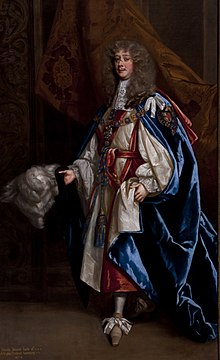Henry Bennet, 1st Earl of Arlington
|
The Right Honourable The Earl of Arlington KG, PC |
|
|---|---|

The 1st Earl of Arlington.
|
|
| Keeper of the Privy Purse | |
| Earl of Arlington | |
| Personal details | |
| Born | 30 January 1618 |
| Died | 28 July 1685 (aged 67) |
| Spouse(s) | Isabella de Nassau |
| Parents | Sir John Bennet of Dawley, Dorothy Crofts |
| Education | Westminster School |
Henry Bennet, 1st Earl of Arlington KG, PC (1618 – 28 July 1685) was an English statesman.
He was the son of Sir John Bennet of Dawley, Middlesex, by Dorothy, daughter of Sir John Crofts of Little Saxham, Suffolk. He was the younger brother of John Bennet, 1st Baron Ossulston; his sister was Elizabeth Bennet who married Sir Robert Carr (or Kerr). He was baptized at Little Saxham, Suffolk, in 1618, and was educated at Westminster School and Christ Church, Oxford. He gained some distinction as a scholar and a poet, and was originally destined for holy orders. In 1643, he was secretary to Lord Digby at Oxford, and was employed as a messenger between the queen and Ormonde in Ireland.
Subsequently, he took up arms for the king, and received a wound on the bridge of his nose in the skirmish at Andover in 1644. The scar resulting from this wound was prominent because Arlington took to covering it with black plaster. After the defeat of the royal cause he travelled in France and Italy, joined the exiled royal family in 1650, and in 1654 became official secretary to James on the recommendation of Charles, who had already been attracted by his "pleasant and agreeable humour." He was said by some to have been the father of an illegitimate child by Lucy Walter.
In March 1657, he was knighted, and the same year was sent as Charles's agent to Madrid, where he remained, endeavouring to obtain assistance for the royal cause, till after the Restoration. On his return to England in 1661 he was made keeper of the privy purse, and became the prime favourite. One of his duties was the procuring and management of the royal mistresses, in which his success gained him great credit. Allying himself with Lady Castlemaine, he encouraged Charles's increasing dislike of Clarendon; and he was made secretary of state in October 1662 in spite of the opposition of Clarendon, who had to find him a seat in parliament. He represented Callington from 1661 till 1665, but appears never to have taken part in debate.
...
Wikipedia
